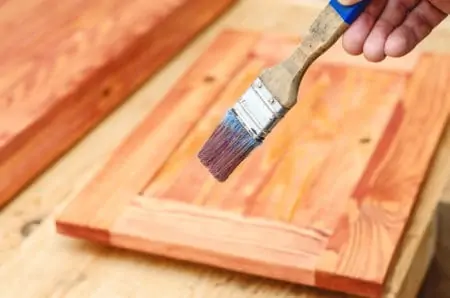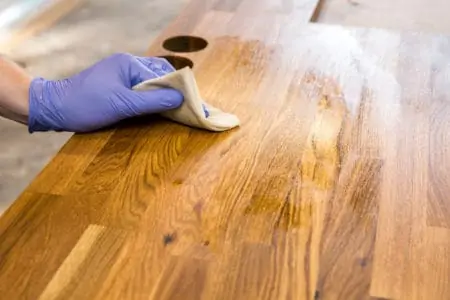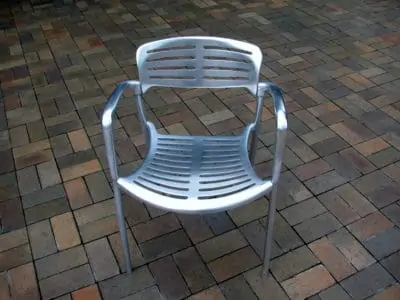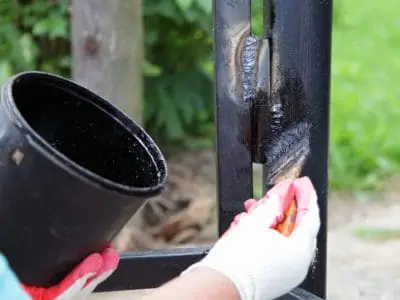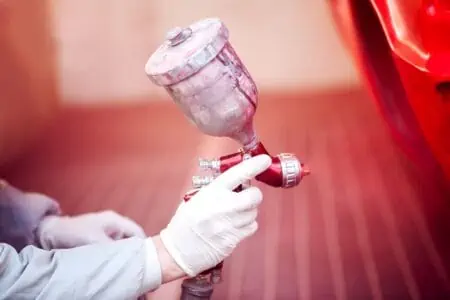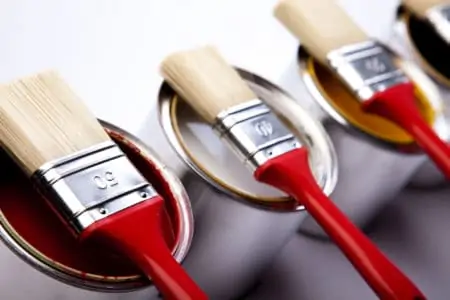Looking after your tools is a must for any professional, and your paintbrushes are no exception. Polyurethane typically starts to dry in two hours, so it can be a challenge keeping your brushes clean.
We show you how to clean polyurethane brushes, including the products you need and tips to make life easier.
Key Takeaways
- Save brushes by cleaning: Preserve the lifespan of your paintbrushes by removing polyurethane after use.
- Water-based polyurethane: Clean with dish soap and warm water, then rinse and dry the brush.
- Oil-based polyurethane: Use mineral spirits, turpentine, or paint thinners to remove, then wash and dry the brush.
- Alternative cleaning methods: Try turpentine, mineral spirits, fabric softener, or baby oil for different types of polyurethane.
- Is It Worth Cleaning Polyurethane Off Your Brush?
- How to Clean Water-Based Polyurethane Off Your Brush
- How to Clean Oil-Based Polyurethane Off Your Brush
- How to Clean Polyurethane Off your Brush Without Paint Thinner
- How Do You Keep Polyurethane From Drying Out on Your Brush?
- How to Clean Polyurethane Off Your Hands
- FAQs
- Brush Up On Your Cleaning
Is It Worth Cleaning Polyurethane Off Your Brush?
Knowing how to get polyurethane off your brush is crucial if you want to preserve the lifespan of your paintbrush. Why? Because polyurethane dries hard and sets the bristles if you don’t clean it immediately after you finish.
You will struggle to use the brush again when that happens because, try as you might, you will still have clumps of bristles. Leaving you with uneven covering and brush lines.
Brushes are not cheap, so they are worth saving, even if they are old but of good quality. The only time you should admit defeat is if the bristles are beyond repair. Clogged brushes are incredibly challenging to bring back to life.
How to Clean Water-Based Polyurethane Off Your Brush
Water-based polyurethane is easier to shift than oil-based products because it doesn’t contain solvents. It cleans with soap and water rather than with mineral spirits. Removing paint without paint thinner is also better for the environment.
What You’ll Need
- Container.
- Dish soap.
- Warm water.
- Paper towels.
- Paintbrush comb.
1. Soak The Brush
Before soaking, read the label to determine that you are using a water-based product. Grab an old container and fill it with warm water, adding a few drops of dish soap.
Dip the brush in the water and swish the brush around to loosen the polyurethane. The water will start to change color.
2. Repeat this Process
Empty the container when it becomes too clogged with polyurethane and refill it with clean water. Repeat the dipping process until the water is clear.
Top Tip
Make sure you immerse bristles up to the ferrule (the metal cap) because this is where most of the paint collects.
3. Head to the Sink
Take the brush to the sink and run it under the faucet with warm water. Add a couple more drops of dish soap to the bristles to help loosen the polyurethane. Keep working the bristles until that water runs clear.
4. Shake Out the Brush
Flick the brush several times to remove the excess water. Keep doing this until no more water comes out. Dab the bristles onto an old rag or paper towels to dry the brush. You can also use a brush comb like this Rollingdog 4-in-1 Comb to shape the bristles.
5. Hang the Brush to Dry
Insert a rod into the handle of the brush and hang it to dry. Gravity straightens the bristles and helps them to hold their shape.
How to Clean Oil-Based Polyurethane Off Your Brush
It is a little trickier cleaning oil-based polyurethane off your brush. Doing it without paint thinner or mineral spirits is not an option.
Take Note
Oil-based products like this Minwax Fast-Drying Polyurethane are extremely popular because they dry quickly and provide first-class protection.
What You’ll Need
- Container.
- Dish soap.
- Warm water.
- Paper towels.
- Paintbrush comb.
1. Add Paint Thinner to a Container
Add paint thinner to a plastic container. You will need enough to cover the bristles up to the ferrule (the metal bit that holds the bristles in place). If you don’t have thinner, you can use mineral spirits.
2. Dip the Brush
Pop the paintbrush into the thinner and leave it for 20 minutes. After the time has elapsed, move the bristles from side to side to work the polyurethane loose. You will see the thinner change color as it starts to remove the polyurethane.
3. Repeat
Pour the contaminated thinner into a sealed bottle, then add some fresh thinner and repeat this process. Keep working the brush back and forth until all the paint has come away. You’ll know when this has happened because the thinner remains clear.
You cannot throw thinner in the trash or down the sink. It has to be disposed of at authorized locations.
4. Wash Out the Thinner
Pour dish soap onto the bristles and hold the paintbrush under the faucet. Pop on some rubber gloves to protect your hands from the thinner. Work the dish soap into the bristles until it creates a thick lather.
Rinse it under the tap and then massage the bristles again. You are looking for fewer suds each time you complete this process. Eventually, you will have washed the thinner and excess dish soap from the brush.
5. Time to Dry
Dab the excess moisture from the bristles by running them over a paper towel or dry cloth. Then hang the brush up to dry, and gravity will reform the shape of the bristles.
Never leave the brush standing on the bristles, as this will misshape the brush.
How to Clean Polyurethane Off your Brush Without Paint Thinner
There are other ways to clean polyurethane off your brush that don’t involve thinner. Other products exist that will do an equally adequate job of cleaning your brushes. Plus, these methods also work if you need to clean your paint brushes after staining or using varnish.
The method you choose should be compatible with the type of paint, stain or varnish used. For example, an oil-based paint will not come off with a water-based product and vice versa.
What You’ll Need
- Container.
- Bucket.
- Brush comb.
- Water.
- Dish soap.
- Paper towels.
- Turpentine.
- Mineral spirits.
- Fabric softener.
- Vinegar.
- Baby oil.
Using Turpentine
1. Remove Excess Paint
Wipe the excess paint from your bristles before attempting to clean it. Then wrap the bristles in a paper towel and squeeze them from the ferrule to push out what color is left.
2. Pour Turpentine into a Container
Fill the container halfway and immerse the brush into the turpentine. Swish it around, pressing the bristles against the sides to work the remaining paint loose. Keep doing this until the paint is removed.
3. Wash the Brush
Hold the brush over the sink, pour on some dish soap and wash it under the faucet. Work the bristles with your fingers, massaging the soap so it reaches every part, including the ferrule. If you see no more paint, rinse the brush under the tap and pat it dry on a paper towel.
Wrap the bristles in paper towels and squeeze the excess water out.
Now hang the brush to dry.
Using Mineral Spirits
1. Don Safety Gear
Mineral spirits have a strong odor, so to avoid inhaling potentially hazardous fumes, wear a face mask and goggles. You also need to protect your skin, so wear rubber gloves.
2. Fill a Container with Mineral Spirits
Pour in the mineral spirits to about halfway, so the brush ferrule is fully submerged. Once you have wiped off the excess paint, drop the brush in the container. Swish the brush around, pressing the bristles on the side of the container.
When no more paint comes off the brush, it’s time to clean it.
3. Wash the Brush
Add dish soap to the bristles and massage it in. Then run the brush under the tap to wash away any remaining paint. Pat it dry on a paper towel when you are satisfied the paint is gone, then hang it to dry.
Using Fabric Softener
1. Fill the Bucket
Pour a cup of fabric softener into a bucket and add a gallon of warm water. Now mix the two ingredients.
2. Drop Your Brush In
Place your paintbrush into the liquid and stir it vigorously until the paint starts to lift off the bristles. You should see the color settle at the bottom of the bucket. When you can’t see any paint on the brush, lift it out and pat it dry with a paper towel.
Crucial Information
Fabric softener will not remove oil-based paints. It only works on water-based products, but it is an excellent way of cleaning dried brushes.
Using Baby Oil
Using baby oil employs the same method as mineral spirits, except you don’t need the safety equipment. Fill a container with baby oil halfway and drop the brush in. Using the same techniques as before, wash the paint out of the brush.
Then, wash the baby oil out of the bristles using dish soap and water, and dry the brush the same way as before. This method will only work with oil-based paints.
Don’t add water to the baby oil as it will split the oil and reduce its cleaning power.
How Do You Keep Polyurethane From Drying Out on Your Brush?
You might not want to clean your brush when you have finished painting for the day and have more to do tomorrow. If so, this method keeps your brush usable without allowing it to dry out.
Simply, wrap the brush in kitchen wrap and pop it into the fridge. It should keep the paint moist for at least two days. If you are thinking of leaving the brush for longer, put it in the freezer.
The freezer method will only keep your brush fresh for a maximum of two weeks. You will need to clean your brush if you are leaving it any longer between uses.
The other method is to use a zip lock bag to seal the paint from the air, but you will still need to keep it in a cool place overnight.
How to Clean Polyurethane Off Your Hands
Cleaning your brushes is all well and good, but what about the polyurethane on your skin? You should wash your hands when the paint is wet in an ideal world, but that means stopping every five minutes.
Here are some tips:
Solvent Removers
Grab some cotton swabs and soak them in the solvent remover of your choice. Mineral spirits like this Sunnyside Corporation Low Odor Thinner and paint thinners are probably the most caustic on your skin, so use them sparingly.
Dab at the paint spots, and you will see it lift off your skin. When the paint is gone, thoroughly clean your hands to wash away the solvent.
Solvents remove oil-based polyurethane, so they won’t work on water-based products.
Baby Oil
Baby oil is a kinder way to remove oil-based paints (and it leaves your skin baby soft). It’s the same technique as before, but you can be a bit more liberal with how you apply it. Dab the polyurethane spots with cotton swabs soaked in the oil.
It breaks the paint down and lifts it off your skin. When it has been removed, wash your hands in soap and water.
Soap and Water
If you are using water-based polyurethane, washing your hands in soap and water is all it takes to remove it.
FAQs
Brush Up On Your Cleaning
Keeping your paintbrushes clean is the only way you can preserve their usability. Brushes are expensive, and the cost of replacing them can soon rack up, so keeping them clean saves you money.
A good worker always looks after their tools, so show your paintbrushes some love.
